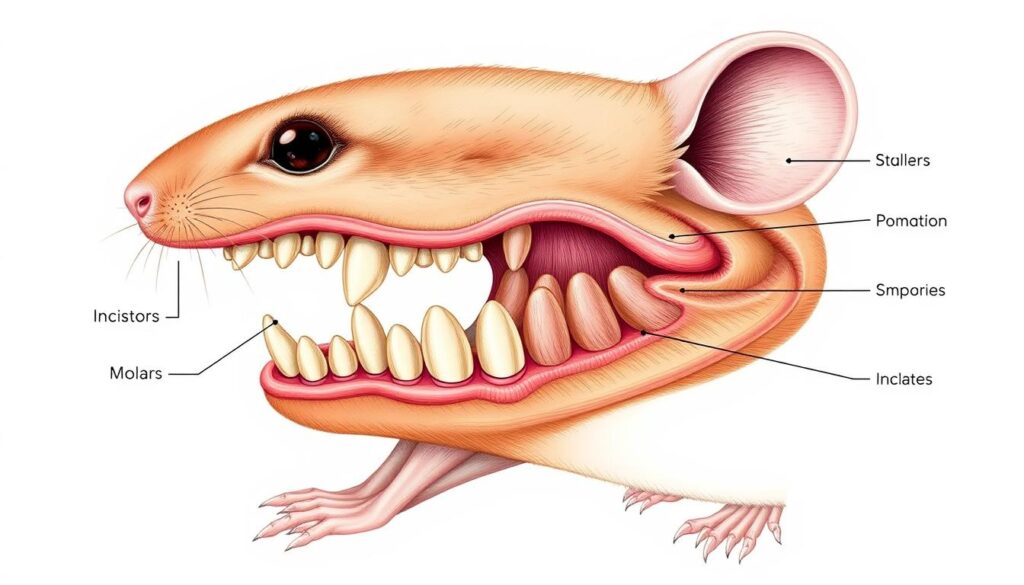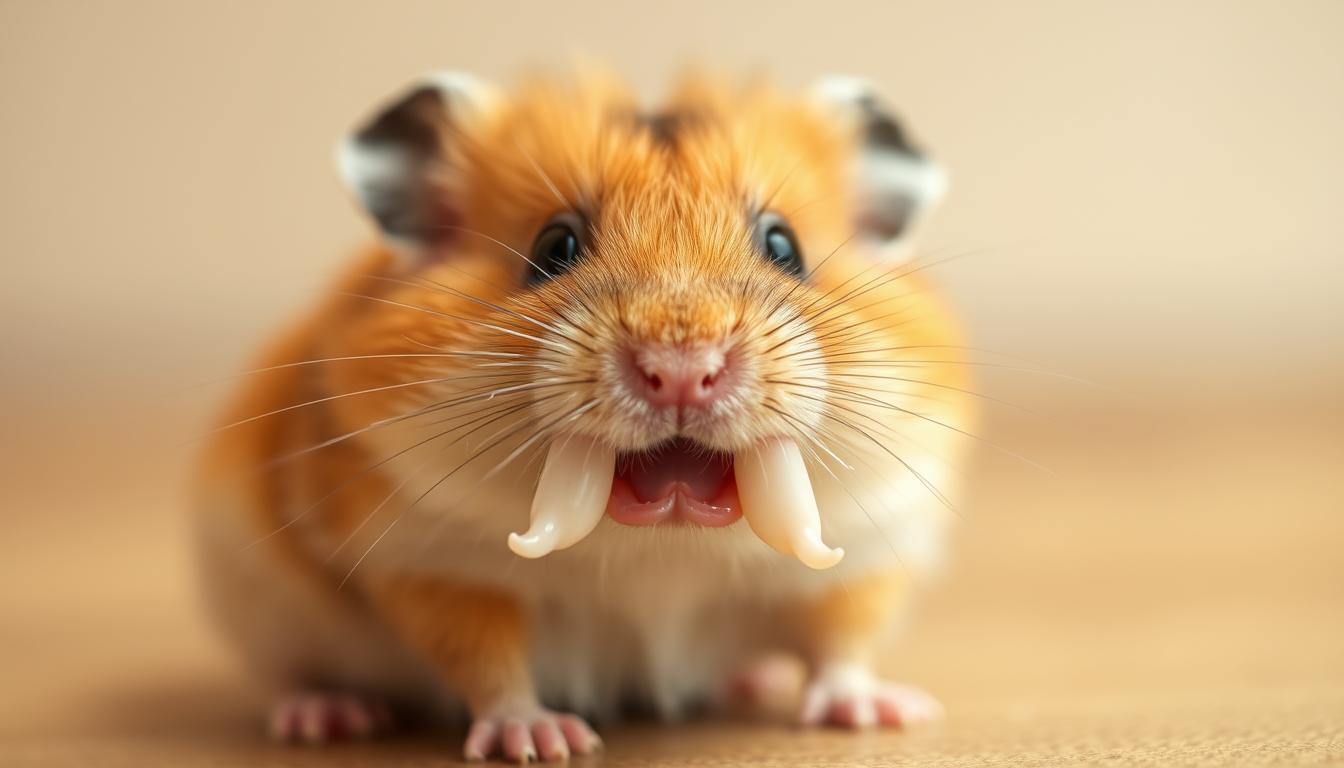Ever thought about your furry friend’s teeth? Knowing about hamsters’ dental anatomy is both interesting and important for their health. In this guide, we’ll dive into a detailed hamster teeth diagram labeled. It will highlight the amazing features of their teeth.
Key Takeaways
- Hamsters have a specialized dental structure adapted for their diet and chewing needs.
- The labeled hamster teeth diagram will help you identify the different types of teeth and their functions.
- Understanding the significance of proper dentition is crucial for maintaining your hamster’s overall health.
- Rodent dental structure has evolved over time to meet their unique feeding requirements.
- Proper dental care is essential to prevent overgrowth and ensure your hamster’s comfort and well-being.
Exploring the Unique Dental Anatomy of Hamsters
Hamsters have a special dental structure that makes them stand out. Let’s take a closer look at their unique features. We’ll explore how important proper dentition is for these small pets.
An Overview of the Rodent Oral Cavity
The hamster’s mouth is quite interesting. They have two growing incisors in each jaw. There’s also a gap between these incisors and their molars. This setup helps them chew and grind their food well.
Understanding the Significance of Proper Dentition
Good dental health is key for hamsters. Their teeth help them chew and digest food properly. Healthy teeth and gums also prevent problems like hamster teeth overgrowth.
Knowing about the rodent oral cavity illustration and the importance of dentition helps pet owners. It shows why giving them the right pet hamster dental care guide is crucial for their health.
Hamster Teeth Diagram Labeled: A Closer Look
To understand hamsters’ dental anatomy, let’s look at a detailed diagram. It shows the parts of their teeth. This helps us see how each tooth works and why they’re important.
The labeled diagram shows how hamsters’ teeth are special. These features help them survive and stay healthy. Looking at this guide, we learn how hamsters adapt to their environment.

The diagram breaks down a hamster’s teeth into incisors, premolars, and molars. Each tooth has a key role in eating. For example, incisors grow constantly to gnaw on hard plants. Molars help grind food in the end.
Understanding the labeled teeth chart helps us see how hamsters’ teeth work together. This knowledge is key as we learn more about hamsters’ amazing adaptations.
| Tooth Type | Function | Distinguishing Features |
|---|---|---|
| Incisors | Gnawing and cutting | Continuously growing, chisel-like shape |
| Premolars | Grinding and chewing | Flat, molar-like surface for crushing and grinding |
| Molars | Mastication and further grinding | Complex, multi-cusped surface for thorough chewing |
Incisors: The Constantly Growing Powerhouses
Hamster incisors are the most distinctive part of their teeth. These teeth grow all the time. They help hamsters chew and gnaw well, making them very important.
Anatomy and Function of Hamster Incisors
Hamster incisors are shaped like a curve and grow continuously. They have hard enamel on the front and softer dentine on the back. This makes them sharp and self-sharpening, helping hamsters eat their food easily.
These teeth are key for hamsters to do daily tasks. They help hamsters eat hay, grains, and even chew on toys. Their sharp teeth help break down hard food, aiding digestion and keeping their teeth healthy.
| Incisor Anatomy | Function |
|---|---|
| Curved shape | Efficient biting and gnawing |
| Continuously growing | Maintain sharp edge for lifelong chewing |
| Enamel front, dentine back | Self-sharpening cutting edges |
Understanding hamster incisor anatomy and its role helps us see how these rodent dental structures adapt. They are well-suited for their natural habitats and as pets.
Molars: The Masticating Marvels
Hamsters have powerful incisors and molars that are key to their dental health. These molars help grind and process their varied diet. They are a vital part of a hamster’s dental structure.
Hamster molars are found at the back of their mouth, behind the incisors. They have a special shape that helps chew and mash food. The molars’ surface is covered in sharp ridges, which break down tough plant material and other foods.

Like their incisors, hamster molars grow continuously. This keeps them sharp and functional. It helps the hamster to efficiently grind and process its food.
The rodent dental structure shows how these animals have adapted to different environments. Learning about hamster molar teeth gives us insight into their resilience and adaptability.
Rodent Dental Structure: Evolutionary Adaptations
To understand hamsters’ unique teeth, we must look at their evolution. Their teeth evolved to fit their diet, showing us why dental care is key for these pets.
How Hamster Teeth Evolved for Their Diet
Hamsters have teeth that grow constantly, thanks to evolution. Their incisors stay sharp for eating plants. This lets them chew on seeds, grains, and tough plants.
Their molars also evolved for their diet. These teeth grind down tough plants, helping hamsters digest their food well. The molars’ unique surfaces help them get the most nutrition from plants.
Hamsters also chew a lot, which helps their teeth stay healthy. This behavior stops their teeth from growing too long. It keeps their teeth in good shape.
Knowing how hamsters’ teeth evolved helps us see why their dental care is important. It shows us how to keep their teeth healthy and strong.
Pet Hamster Dental Care: Preventing Overgrowth
Keeping your pet hamster’s teeth healthy is key to their happiness. Hamsters’ teeth grow all the time. If not cared for, they can grow too long, causing pain and health problems. Here, we’ll share easy ways to keep your hamster’s teeth in great shape and avoid dental issues.
Tips for Maintaining Optimal Dental Health
Offering your hamster different chew toys is vital for their dental health. Toys like wooden blocks or hay-based items help wear down their teeth. This keeps their bite right and stops teeth from getting too long. Also, taking your hamster to the vet regularly is important to catch any dental problems early.
Feeding your hamster a diet full of fiber is also good for their teeth. Hay, fresh veggies, and chewy treats strengthen their teeth and jaws. By following these simple steps, you can stop overgrowth and keep your hamster’s smile bright and healthy.




